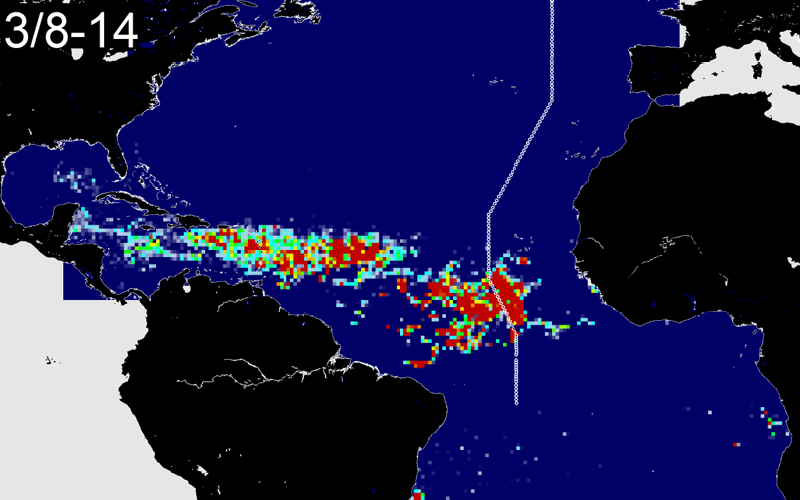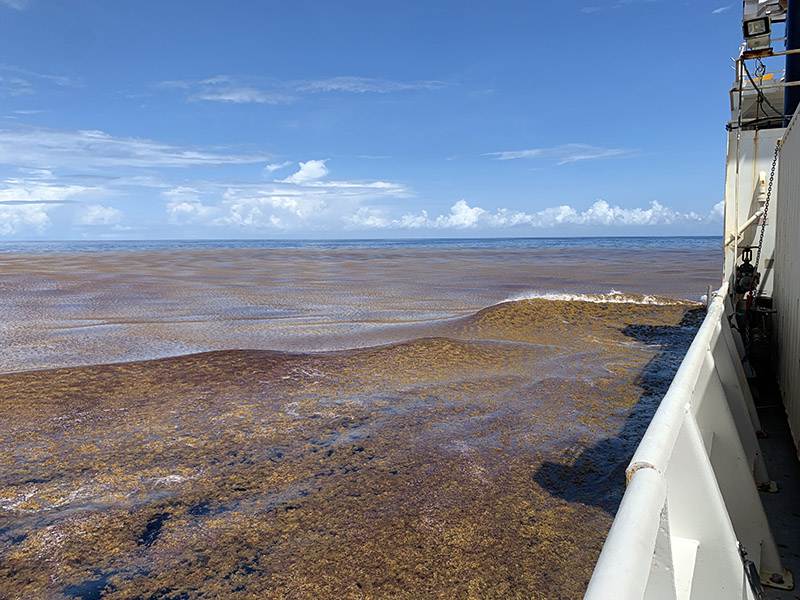This article was adapted from an announcement by the Woods Hole Oceanographic Institute.
Under normal conditions, the floating macroalgae Sargassum spp. provide habitat for hundreds of types of organisms. However, the Great Atlantic Sargassum Belt (GASB) that emerged in 2011 has since then caused unprecedented inundations of this brown seaweed on Caribbean and Florida coastlines, with harmful effects on ecosystems while posing concerns for regional economies and public health.
In a recent journal article published in Nature Communications, researchers say they have identified that the nutrient content of Sargassum tissue could help determine the enrichment sources and potentially improve predictions and Sargassum management efforts.
“This study shows nutrient enrichment in Sargassum in the western portion of the Great Atlantic Sargassum Belt as compared with Sargassum in the Sargasso Sea,” said Chuanmin Hu, professor and director of the Optical Oceanography Lab at the University of South Florida College of Marine Science, and one of the study’s co-authors. “The findings point to the need for more measurements to pinpoint the nutrient sources. This is a critical step toward the understanding of the increased Sargassum inundations in recent years.”
Hu’s satellite-based Sargassum maps provided the context of the Sargassum samples as well as their oceanic environments.

The Great Atlantic Sargassum Belt seen from satellite. Image courtesy of Chuanmin Hu and Brian Barnes.
A variety of nutrient sources for the GASB blooms have been suggested, including upwelling, vertical mixing, discharge from the Amazon and Congo rivers, and atmospheric deposition. However, the paper states that the causes of the GASB and the mechanisms controlling its variability remain unknown.
The paper also indicates that the nutritional status of Sargassum in the GASB is enriched, with higher nitrogen and phosphorus content than the populations of Sargassum that reside in its Sargasso Sea habitat.
“In its traditional environment, Sargassum is a great ecological benefit,” said Dennis McGillicuddy, Jr., senior scientist in the Applied Ocean Physics and Engineering Department at the Woods Hole Oceanographic Institution (WHOI) and the article’s lead author. “However, the proliferation of biomass in the tropical Atlantic has proven the old adage that too much of a good thing can be bad.”
The finding that nitrogen and phosphorus are higher in the GASB than in the Sargasso Sea “is a smoking gun that the GASB inundations are nutrient-driven,” said McGillicuddy. “A consequence of this finding is that it presents us potentially with the opportunity to use those nitrogen and phosphorus markers in Sargassum tissue to fingerprint the ultimate sources of these nutrients that are sustaining these seaweed blooms.”
In addition, the paper notes that the presence of arsenic in Sargassum tissue – which reflects phosphorus limitation – significantly constrains the utilization of the seaweed biomass that washes ashore.
“As the Great Atlantic Sargassum Belt has grown over the last decade, the public has become increasingly aware of this phenomenon and its impact on coastal communities,” said Peter Morton, research scientist in the Department of Oceanography at Texas A&M University, College Station and a co-author of the study. “Our research shows that Sargassum could become enriched in arsenic, depending on the conditions in which it grows. Plans to remove or exploit this material when it washes ashore should consider the potential for Sargassum to contain high concentrations of arsenic, so we encourage affected communities to proceed with caution when exploring options to deal with seasonal inundations of Sargassum.”
Due to the threats that the Sargassum inundations pose to the environment, economy, and human health, the paper recommends the need for expanded observational and modeling studies to understand the GASB’s physical, biological, and chemical drivers.
McGillicuddy and co-author Brian Lapointe also stressed the importance of the interdisciplinary and collaborative nature of this research, which encompasses several disciplines including biology, chemistry, and physics.
“This collaborative study illustrates the value of interdisciplinary research teams to understanding complex oceanographic phenomena in an era of rapid global change, in this case, the Great Atlantic Sargassum Belt that formed in 2011,” said Lapointe, a research professor at Florida Atlantic University’s Harbor Branch Oceanographic Institute, and one of the world’s foremost authorities on Sargassum.
Funding for this research was provided by the National Science Foundation, the National Institute of Environmental Health Sciences through the Woods Hole Center for Oceans and Human Health, WHOI, the Isham Family Charitable Fund, the State of Florida, and NASA.
